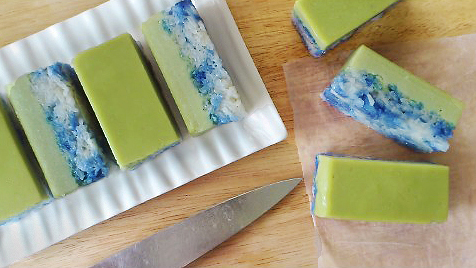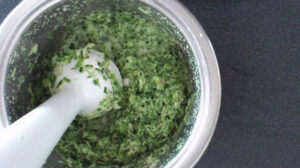Kuih Seri Muka (Kueh Salat) (II)

To live up to its name, kuih seri muka must have a layer of custard that’s smooth as a baby’s bottom. Why? Because “seri muka” means beautiful face.
Kuih seri muka is also called kueh salat.
Kuih Seri Muka doesn’t just look good. It tastes good too. The rice layer is firm, not mushy. The custard layer is soft, smooth and rich. These two different layers complement each other very well.
Unlike humans, kuih doesn’t need cosmetics, plastic surgery or botox. All it requires is low, gentle heat whilst it’s cooking, and the “muka” would be “seri” as can be.
Making kuih salat is easy, especially if you have a steam oven or electric steamer with temperature control. If you have a big rice cooker, you might squeeze a small kuih in there. The warm mode is ideal for steaming the custard layer.
If, like me, you have to use a wok or big pot that fits a cake pan, you can still make a beautiful kuih seri muka. Just keep the steaming water for the custard layer a bit below boiling point by leaving the cover slightly ajar, and the kuih/kueh should be fine.

Kueh Salat (Kuih Seri Muka)
Video
Ingredients
Rice layer
- 250 g glutinous rice
- 5 young pandan leaves rinse, drain, cut to fit pan
- 125 ml water
- 1/2 tsp salt
- 125 ml undiluted freshly squeezed coconut milk
- 50 fresh bunga telang (blue pea flowers) pound, strain, discard pulp
Custard layer
- 5 eggs
- 100 g young light green pandan leaves
- 150 g undiluted fresh coconut milk
- 2 tbsp plain flour
- 1/8 tsp salt
- 115 g sugar
- 90 g water
Instructions
Rice layer
- Whisk eggs thoroughly. Sieve. Set aside.5 eggs
- Wash pandan leaves. Cut ½ cm long. Blend with coconut milk. Strain to yield 150 g liquid. Discard pandan pulp. Add flour, salt, sugar and water to liquid to coconut milk. Set aside.100 g young light green pandan leaves, 150 g undiluted fresh coconut milk, 2 tbsp plain flour, 1/8 tsp salt, 115 g sugar, 90 g water

- Wash glutinous rice. Drain thoroughly.250 g glutinous rice
- Line 18 x 18 x 5 cm cake pan with parchment paper, leaving some overhang. Spread half of rice in pan evenly. Top with pandan leaves, then remaining rice. Add water and sprinkle with salt. Steam 10 minutes over rapidly boiling water. Drizzle with coconut milk. Mix thoroughly. Steam 20 minutes. Discard pandan leaves. Drizzle with bunga telang juice, unevenly. Steam 5 more minutes.5 young pandan leaves, 125 ml water, 1/2 tsp salt, 125 ml undiluted freshly squeezed coconut milk, 50 fresh bunga telang (blue pea flowers)
- Check that rice is cooked. If it isn't, drizzle with 1 tbsp water and steam a few minutes till it's cooked but not mushy. Toss to mix the colours slightly. Press into an even, compact layer with a wet spatula or spoon. Cover and steam another 5 minutes.
- When rice is almost ready, cook coconut milk mixture over medium heat till gently simmering, stirring to dissolve sugar. Remove from heat. Pour half slowly into whisked eggs, stirring to mix eggs and coconut milk evenly. Add egg mixture to remaining coconut milk. Cook combined mixture over low heat, scraping bottom and sides of pot to prevent lumps, till slightly thickened.
- When rice is cooked, pour custard onto rice. Reduce heat to lowest possible. Keep steaming water just below boiling point, with the steamer's cover slightly ajar if necessary. Steam till custard is just set in the middle, 35-45 minutes depending on steaming temperature and thickness of custard before steaming.

- Test custard by inserting skewer in the middle and wriggling slightly (the skewer, not you). If skewer comes out clean, kueh is done.
- Remove kueh to a wire rack. Allow to cool completely and set, 3 hours or so. Unmould by lifting parchment paper, onto a chopping board. Cut kueh with an oiled knife, scraping knife clean after each cut. Discard parchment paper. Serve within 2-3 hours, or refrigerate (up to 2-3 days) to keep kueh from spoiling.